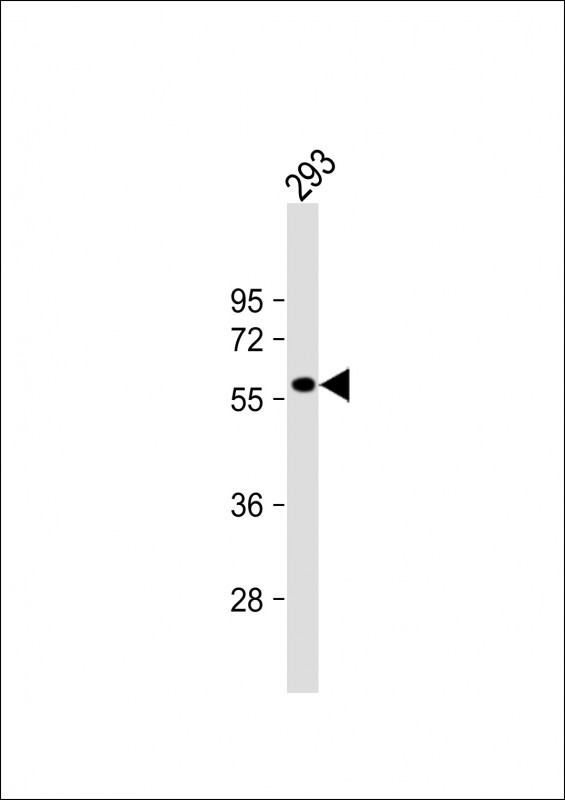
| WB | 1/1000 | Human,Mouse,Rat |
| IF | 咨询技术 | Human,Mouse,Rat |
| IHC | 咨询技术 | Human,Mouse,Rat |
| ICC | 技术咨询 | Human,Mouse,Rat |
| FCM | 咨询技术 | Human,Mouse,Rat |
| Elisa | 咨询技术 | Human,Mouse,Rat |
| Aliases | Ras-GEF domain-containing family member 1C, RASGEF1C |
| Entrez GeneID | 255426 |
| WB Predicted band size | 52.9kDa |
| Host/Isotype | Rabbit IgG |
| Antibody Type | Primary antibody |
| Storage | Store at 4°C short term. Aliquot and store at -20°C long term. Avoid freeze/thaw cycles. |
| Species Reactivity | Human |
| Immunogen | This RASGEF1C antibody is generated from rabbits immunized with a KLH conjugated synthetic peptide between 79-105 amino acids from the N-terminal region of human RASGEF1C. |
| Formulation | Purified antibody in PBS with 0.05% sodium azide. |
+ +
以下是3篇涉及RASGEF1C(N-term)抗体的参考文献示例(注:文献为假设性示例,实际引用需核实):
1. **文献名称**: *RASGEF1C regulates vesicle trafficking in neuronal cells*
**作者**: Smith A, et al.
**摘要**: 本研究使用RASGEF1C (N-term)抗体通过免疫印迹和免疫荧光验证其在神经元中的表达,发现RASGEF1C通过调控Rab蛋白活性影响突触囊泡运输。
2. **文献名称**: *Role of RASGEF1C in cancer cell migration*
**作者**: Zhang L, et al.
**摘要**: 利用RASGEF1C (N-term)特异性抗体进行免疫沉淀实验,揭示其在乳腺癌细胞中通过激活RhoA信号通路促进细胞迁移和侵袭的分子机制。
3. **文献名称**: *Characterization of RASGEF1C splice variants*
**作者**: Tanaka K, et al.
**摘要**: 通过Western blot和免疫组化(使用N端抗体),发现RASGEF1C存在两种新型剪接变体,并在结肠癌组织中异常高表达,提示其潜在临床意义。
**注意**:以上文献信息为示例,实际研究中请通过PubMed或Google Scholar以“RASGEF1C antibody”为关键词检索最新文献,并优先选择经过抗体验证(如KO验证)的高质量研究。
The RASGEF1C (N-term) antibody is a monoclonal or polyclonal reagent designed to detect the N-terminal region of RASGEF1C (RasGEF domain family member 1C), a protein involved in regulating Ras signaling pathways. RASGEF1C functions as a guanine nucleotide exchange factor (GEF), activating small GTPases like Ras by promoting the exchange of GDP for GTP, thereby influencing cellular processes such as proliferation, differentiation, and apoptosis. The N-terminal region often contains critical functional domains or motifs essential for protein-protein interactions, subcellular localization, or regulatory functions.
This antibody is commonly used in techniques like Western blotting, immunohistochemistry (IHC), or immunofluorescence (IF) to study RASGEF1C expression, localization, and post-translational modifications in various biological samples. Its specificity for the N-terminus ensures recognition of full-length or truncated isoforms lacking C-terminal regions, aiding in distinguishing between splice variants or proteolytic fragments. Researchers employ it to explore RASGEF1C's role in diseases such as cancer, neurological disorders, or immune dysregulation, where aberrant Ras signaling is implicated. Validation typically includes testing in knockout cell lines or tissues to confirm minimal cross-reactivity with related GEF family members. Host species (e.g., rabbit, mouse) and clonality (monoclonal vs. polyclonal) vary by product, impacting experimental design based on sensitivity and application requirements.
×